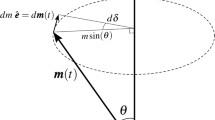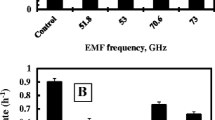Abstract
Previous assays with weak sinusoidal magnetic fields (SMF) have shown that bacteria that had been exposed to a 50 Hz magnetic field (0.1–1 mT) gave colonies with significantly lower transposition activity as compared to sham-exposed bacteria. These experiments have now been extended by using a pulsed-square wave magnetic field (PMF) and, unexpectedly, it was found that bacteria exposed to PMF showed a higher transposition activity compared to the controls. The increase of the transposition activity was positively correlated with the intensity of the magnetic fields (linear dose-effect relation). This phenomenon was not affected by any bacterial cell proliferation, since no significant difference was observed in number and size of PMF-exposed and sham-exposed colonies. In addition, the cell viability of E. coli was significantly higher than that of the controls when exposed to SMF, and lower than that of the controls when exposed to PMF. Under our experimental conditions it was shown that exposure to PMF stimulates the transposition activity and reduces cell viability of bacteria, whereas exposure to SMF reduces the transposition mobility and enhances cell viability. These results suggest that the biological effects of magnetic fields may critically depend on the physical characteristics of the magnetic signal, in particular the wave shape.



Similar content being viewed by others
References
Berg H (1999) Problems of weak electromagnetic field effects in cell biology. Bioelectrochem Bioenerg 48:355–360
Repacholi MH, Greenebaum B (1999) Interaction of static and extremely low frequency electric and magnetic fields with living systems: health effects and research needs. Bioelectromagnetics 20:133–160
Koana T, Okada MO, Takashima Y, Ikehata M, Miyakoshi J (2001) Involvement of eddy currents in the mutagenicity of ELF magnetic fields. Mutat Res 476:55–62
Giorgi G, Guerra D, Pezzoli C, Cavicchi S, Bersani F (1992) Genetic effects of static magnetic fields. Body size increase and lethal mutations induced in populations of Drosophila melanogaster after chronic exposure. Genet Sel Evol 24:393–413
Blank M, Goodman R (2001) Electromagnetic initiation of transcription at specific DNA sites. J Cell Biochem 81:689–692
Pipkin JL, Hinson WG, Young JF et al. (1999) Induction of stress proteins by electromagnetic fields in cultured HL-60 cells. Bioelectromagnetics 20:347–357
Chow KC, Tung WL (2000) Magnetic field exposure enhances DNA repair through the induction of DnaK/J synthesis. FEBS Lett 478:133–136
Goodman R, Blank M (1998) Magnetic field induces expression of hsp70. Cell Stress Chaperones 3:79–88
McCann J, Dietrich F, Rafferty C (1998) The genotoxic potential of electric and magnetic fields: an update. Mutat Res 411:45–86
Scarfi MR, Lioi MB, Zeni O, Della Noce M, Franceschi C, Bersani F (1999) Micronucleus frequency and cell proliferation in human lymphocytes exposed to 50 Hz sinusoidal magnetic field. Health Phys 76:244–250
Loberg LI, Engdahl WR, Gauger JR, McCormick DL (2000) Expression of cancer-related genes in human cells exposed to 60 Hz magnetic fields. Radiat Res 153:679–684
Craig NL, Craigie R, Gellert M, Lambowitz A (eds) (2002) Mobile DNA II. American Society for Microbiology Press, Washington, DC
Kidwell MG, Lisch DR (2001) Perspective: transposable elements, parasitic DNA, and genome evolution. Evolution Int J Org Evolution 55:1–24
Kidwell MG, Lisch D (1997) Transposable elements as sources of variation in animals and plants. Proc Natl Acad Sci U S A 94:7704–7711
Paulsen IT, Banerjei L, Myers GS et al. (2003) Role of mobile DNA in the evolution of vancomycin-resistant Enterococcus faecalis. Science 299:2071–2074
Kretschmer PJ, Cohen SN (1979) Effect of temperature on translocation frequency of the Tn3 element. J Bacteriol 139:515–519
Pfeifer F, Blaseio U (1990) Transposition burst of the ISH27 insertion element family in Halobacterium halobium. Nucleic Acids Res 18:6921–6925
Ratner VA, Zabanov SA, Kolesnikova OV, Vasilveva LA (1992) Induction of the mobile genetic element Dm-412 transpositions in the Drosophila genome by heat shock treatment. Proc Natl Acad Sci U S A 89:5650–5654
Eichenbaum Z, Livneh Z (1998) UV light induces IS10 transposition in Escherichia coli. Genetics 149:1173–1181
Aleshkin GI, Kadzhaev KV, Markov AP (1998) High and low UV-dose responses in SOS-induction of the precise excision of transposons Tn1, Tn5 and Tn10 in Escherichia coli. Mutat Res 40:179–191
Lamrani S, Ranquet C, Gama MJ, Nakai H, Shapiro JA, Toussaint A, Maenhaut-Michel G (1999) Starvation-induced Mucts62-mediated coding sequence fusion: a role for ClpXP, Lon, RpoS and Crp. Mol Microbiol 32:327–343
Ilves H, Horak R, Kivisaar M (2001) Involvement of sigma(S) in starvation-induced transposition of Pseudomonas putida transposon Tn4652. J Bacteriol 183:5445–5448
Ghanekar K, McBride A, Dellagostin O, Thorne S, Mooney R, McFadden J (1999) Stimulation of transposition of the Mycobacterium tuberculosis insertion sequence IS6110 by exposure to a microaerobic environment. Mol Microbiol 33:982–993
Del Re B, Garoia F, Mersica P, Agostini C, Bersani F, Giorgi G (2003) Extremely low frequency magnetic fields affect transposition activity in Escherichia coli. Radiat Environ Biophys 42:113–118
Huisman O, Kleckner N (1987) A new generalizable test for detection of mutations affecting Tn10 transposition. Genetics 116:185–189
Sambrook J, Fritsch EF, Maniatis T (1989) Molecular cloning. A laboratory manual. Cold Spring Harbor Laboratory Press, 2nd edn. Cold Spring Harbor, New York
Giorgi G, Cavicchi S, Bersani F (1997) Evidence of changes in genomic location of transposable elements in Drosophila melanogaster exposed to static magnetic fields. In: Bersani F (ed) Electricity and magnetism in biology and medicine. Kluwer Academic/Plenum Publishers, New York, pp 687–689
Kivisaar M (2003) Stationary phase mutagenesis: mechanisms that accelerate adaptation of microbial populations under environmental stress. Environ Microbiol 5:814–827
Chow KC, Tung WL (2000) Magnetic field exposure stimulates transposition through the induction of DnaK/J synthesis. Biochem Biophys Res Commun 270:745–748
Taddei F, Halliday JA, Matic I, Radman M (1997) Genetic analysis of mutagenesis in aging Escherichia coli colonies. Mol Gen Genet 256:277–281
Bjedov I, Tenaillon O, Gerard B et al. (2003) Stress-induced mutagenesis in bacteria. Science 300:1404–1409
Obo M, Konishi S, Otaka Y, Kitamura S (2002) Effect of magnetic field exposure on calcium channel currents using patch clamp technique. Bioelectromagnetics 23:306–314
Costa JG da, Moura MA de, Consoni L, Nogueira RA (2002) Can electromagnetic radiations induce changes in the kinetics of voltage-dependent ion channels? Cell Mol Biol (Noisy-le-grand) 48:577–583
Marino AA, Kolomytkin OV, Frilot C (2003) Extracellular currents alter gap junction intercellular communication in synovial fibroblasts. Bioelectromagnetics 24:199–205
Acknowledgements
This study was supported by a grant from the Ministry of University and Reseach (5% MIUR - “Salvaguardia dell’uomo e dell’ambiente dalle emissioni elettromagnetiche”).
Author information
Authors and Affiliations
Corresponding author
Rights and permissions
About this article
Cite this article
Del Re, B., Bersani, F., Agostini, C. et al. Various effects on transposition activity and survival of Escherichia coli cells due to different ELF-MF signals. Radiat Environ Biophys 43, 265–270 (2004). https://doi.org/10.1007/s00411-004-0260-9
Received:
Accepted:
Published:
Issue Date:
DOI: https://doi.org/10.1007/s00411-004-0260-9




